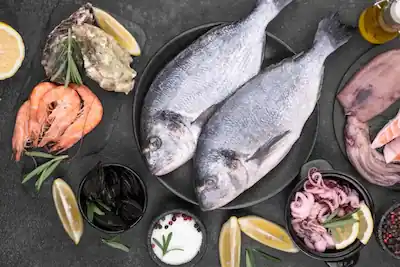SEAFOOD TESTING

The marine food/seafood products business continually evolves with consumer demand. During various fishing and aquaculture operations, the food may be subjected to dangerous residues (such as histamines and biotoxins), organic and inorganic pollutants (such as heavy metals, dioxins, and radioactivity), veterinary medication residues, and other contaminants. Our marine food/seafood testing facility in Chennai can assist producers in identifying and addressing these problematic parts of the process.
Our advanced seafood testing technology and our dedicated group of experts let us analyze the freshness of food while following national and international hygiene and grading requirements
Why is Marine Food/Seafood Testing Required?
Safety Assurance:
Marine food/Seafood may include heavy metals, infections, and other pollutants from the marine environment. By identifying and reducing these dangers, testing guarantees that marine goods are safe for human intake.
Quality Control:
Consumer expectations for quality control include that seafood will be tasty, fresh, and free from flaws. Testing improves client pleasure by confirming that these items fulfil quality requirements.
Regulatory Compliance:
Strict rules and regulations have been set for marine goods by governments and international organizations. By ensuring that these items meet these criteria through marine testing, global trade is facilitated and public health is protected.
Some of the key seafood testing we perform are:
| TEST CATEGORY | PARAMETERS CHECKED | PRACTICAL APPLICATIONS |
|---|---|---|
| MICROBIOLOGICAL TESTING | The existence of dangerous pathogens such as Salmonella and E. coli. Total microbial contamination. | Locates and controls bad microorganisms, guaranteeing safe seafood. |
| HEAVY METAL TESTING | Heavy metal concentrations, including mercury, lead, and cadmium | Reduces the health risks from heavy metal contamination by detecting it at an early stage. |
| CHEMICAL CONTAMINANT TESTINGG | Detection of chemical contaminants like PCBs, dioxins, and pesticides. | Such products do away with harmful chemical residues, making sure that consumers are healthy. |
| SENSORY EVALUATION | Appearance, taste, odour, and texture to assess overall product quality. | Helps maintain product quality, boost consumer satisfaction and assist in marketing. |
| NUTRITIONAL ANALYSIS | Nutrient content, including Omega-3 fatty acids, vitamins, and minerals. | Gives nutritional information to assist in intelligent food choices. |
| WATER QUALITY ANALYSIS | Parameters like pH, dissolved oxygen, and pollutants in the water to assess the impact on aquatic life. | Healthy marine environments are maintained. Marine ecology and sustainability being preserved. |
Marine Food/Seafood Testing Parameters:
| Salt content | Total Volatile Base Nitrogen (TVBN) | Protein | Tri methyl amine (TMA) |
| Sulphur dioxide (Sodium meta bisulphate as SO2) | Moisture | Phosphate (as PO4) Polyphosphate (as P2O5) | Total fat |
| Total Ash |
Advancements in Technology, Equipment and Laboratory staff reveal the CVR Labs as the number one choice for marine food/seafood testing services. To find out about our services CONTACT US today.
